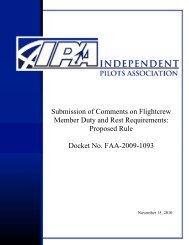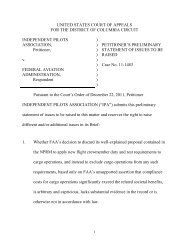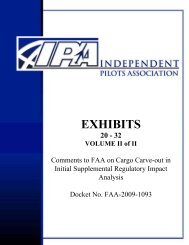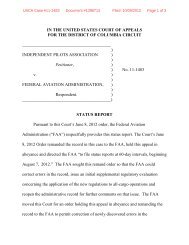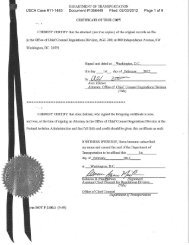Brief Addendum - Independent Pilots Association
Brief Addendum - Independent Pilots Association
Brief Addendum - Independent Pilots Association
You also want an ePaper? Increase the reach of your titles
YUMPU automatically turns print PDFs into web optimized ePapers that Google loves.
2<br />
Another DC-8-63, N788AL, was scheduled to be ferried from Dover,<br />
Delaware (DOV), to MCI by the captain, first officer and flight engineer, who<br />
would later be involved in the accident in N782AL. This flightcrew had completed<br />
a regular cargo flight from Germany and were on a off-duty rest break in DOV.<br />
AT1 flightcrew scheduling personnel later assigned the captain and his crew to the<br />
three-engine ferry operation of N782AL to be conducted from MCI to CEF. The<br />
AT1 chief pilot was consulted about this assignment and gave approval for the flight,<br />
although flightcrews more experienced in three-engine takeoffs were available at<br />
MCI. According to the chief pilot, he telephoned the captain and discussed with<br />
him some of the details for the later three-engine ferry flight, including the weather<br />
forecast of possible adverse winds during the landing at CEF. Additional<br />
discussions occurred concerning a landing curfew at CEF of 2300 eastern standard<br />
time and how this would impact the flight. If the captain was unable to arrive before<br />
the landing curfew, it was decided to use Bradley International Airport (BDL),<br />
Windsor Locks, Connecticut (about 17 nautical miles southwest of CEF), as an<br />
alternate.<br />
The captain and his crew departed DOV on the first ferry flight and<br />
arrived in MCI at 1739 on the day of the accident. The block-to-block time for the<br />
flight was 3.3 hours. AT1 arranged for a qualified atiame and powerplant (A&P)<br />
mechanic to fly from DEN to MCI to prepare N782AL for the three-engine ferry.<br />
The captain prepared the flight departure papers and discussed fueling requirements<br />
with another AT1 captain who had flown N782AL to MCI. Both captains agreed<br />
that the fuel load should be 75,000 pounds, to include 30,000 pounds of ballast fuel<br />
and 45,000 pounds of usable tiel. The computer flight plan provided to the captain<br />
estimated an en route time of 2 hours and 7 minutes for the flight fom MCI to CEF.<br />
Based on this estimated time, N782AL would have had to take off prior to 1953, in<br />
order to arrive at CEF before the curfew. The A&P mechanic, who prepared<br />
N782AL for departure, stated that he was present in the cockpit when the captain<br />
reviewed the three-engine ferry procedures with the other two crewmembers with<br />
the aid of the flight manual.<br />
About 1955, the engine start procedure was initiated. The No. 4<br />
engine would not start on the first attempt because an ignition circuit breaker had<br />
inadvertently been left open. The circuit breaker was reset, although some pooled<br />
fuel in the cowling did momentarily torch, and a successful engine start was<br />
eventually accomplished. All three engines were operating by 2004. Following the<br />
fuel torching episode, the captain indicated that he was going to continue the start<br />
57



